Improving user/customer experience in every industry with clean address data
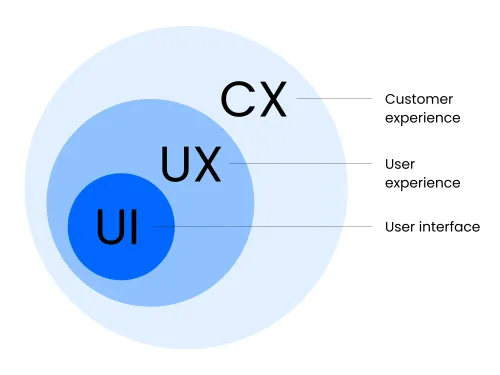

You finally track down an essential addition to your collector’s set of [insert item of your choice], and you're hyped to buy it until the chaos begins.
The cart is hidden in a fly-out on the side, cluttered with blocky, overwhelming text. You spend way too long just trying to find the "Proceed to Checkout" button.
👎 That’s bad UI (user interface): messy, confusing design that makes navigation a chore.
You make it to the checkout and start entering your info, but the site keeps rejecting your address. You retype it. Again. And again.
👎 That’s bad UX (user experience): clunky, frustrating interactions that make users want to throw their device across the room.
Let’s say the order finally goes through… but it turns out that a tiny typo snuck in during all of that retyping, and the package is sent to the wrong place.
👎 That’s bad CX (customer experience): failed delivery, no follow-up, and a customer who's annoyed enough to never come back.
If you want to get in on improving the customer and user experience for any industry, keep reading to learn about:
- What are UI, UX, and CX?
- What’s the difference between UI/UX and CX?
- What is address data (and why should you care?)
- How address data improves UI, UX, and CX by industry
- Address data is the unsung hero of great experiences
What are UI, UX, and CX?
UI is what people see and click.
UX is how they feel while using your product.
CX is the entire journey—from discovery to delivery.
And address data? It quietly powers all three.
From clean, automatic address verification in forms to accurate deliveries and smooth onboarding, good address data eliminates friction, boosts satisfaction, and keeps your customers coming back.
Let’s break down the differences and discuss how fixing your address data can improve your UI, UX, and CX.
What’s the difference between UI/UX and CX?
The difference between the three breaks down to who the user is and if they can easily achieve the desired outcome:
What is the user interface? (UI)
UI is the visual elements and appearance of the website that your customers interact with, such as colors, shapes, layout, typography, etc. It’s what your users see and touch—when done wrong, it can cause serious friction.
Some classic red flags include:
- Cluttered layout – Too many buttons, menus, modals = overwhelmed users.
- Non-intuitive navigation – Users shouldn’t need a GPS to find the checkout button.
- Slow response times – Laggy interfaces feel like dial-up in a 5G world.
- Poor contrast or visuals – Bad font choices, colors that burn your retinas, or buttons that blend into the background.
- Inconsistency – UI elements that change design/function unpredictably
What is the user experience? (UX)
UX refers to the customer experience with your product or website. How easy, intuitive, and enjoyable is the customer’s interaction with your website, app, or digital product?
Good UX means your product is:
- Easy to use – Customers complete tasks quickly without frustration
- Efficient – Sites and apps run smoothly
- Accessible to everyone – People of all abilities can perceive and interact with your content
- Simple to navigate – Intuitive layouts with no extra clutter
What is customer experience (CX)?
CX zooms out to cover the entire relationship between a customer and your brand. It includes everything: from the first ad a customer sees to the support they get after the sale.
Great CX includes:
- Brand perception – How customers feel about your brand over time
- Customer support – How easy it is to get help when needed
- Logistics and fulfillment – Fast, accurate deliveries
- Personalization – Tailored recommendations and experiences
🧙♂️ Think of it like this: UX is Gandalf guiding Frodo through the Shire (the app or site). UI is the map, the sword, the ring, the cloak of elven design (the gear you give your user to help them on the journey), and CX is the entire epic journey to Mount Doom—every interaction along the way matters.
So, how does address data tie into all of this?
What is address data (and why should you care)?
Address data is the info that pinpoints a location—think street, city, ZIP Code, even GPS coordinates. It powers essential touchpoints like deliveries, signups, and compliance.
From ecommerce and telecom to healthcare, insurance, and fintech, accurate address data reduces friction, boosts efficiency, and builds trust. It shortens forms, speeds up checkouts, ensures communications land where they should, and keeps services running smoothly.
Around 20% of online addresses have errors, creating a domino effect on customer experience, costs, and compliance. And failed deliveries? They cost businesses an estimated $197 billion each year. Yikes.
So yeah, accurate address data is kind of a big deal.
It improves UI, UX, and CX by:
UI (User Interface)
- Making forms shorter and cleaner
- Standardizing layout for a polished look
- Validating addresses in real-time to prevent the “red error text of doom”
UX (User Experience)
- Fewer keystrokes = fewer drop-offs
- Reducing form abandonment (especially on mobile)
- Avoiding delivery fails and account errors
CX (Customer Experience)
- Creating trust with smooth signups and checkouts
- Getting stuff where it needs to go—fast
- Powering compliance (hello, KYC and HIPAA)
Looking for more specifics? Great—next up, we’ll break it down by industry.
How address data improves UI, UX, and CX by industry
Retail/shipping/ecommerce customer experience
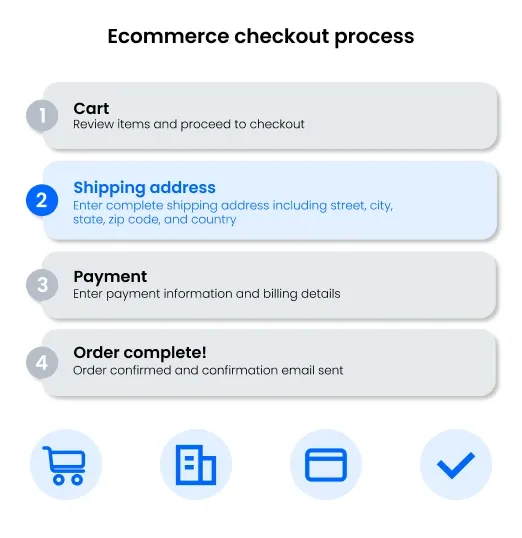
When it comes to keeping customers happy and coming back, the ecommerce customer experience hinges on a smooth checkout experience. In fact, 72% of customers say they’d ditch a brand after just one bad experience—yikes. Add in the fact that nearly 70% of online shopping carts are abandoned, often due to clunky checkout flows, and it’s clear: there’s zero room for friction.
Accurate address data helps enhance the ecommerce customer experience by:
- Autocomplete – speeds up address entry by 30–50%, reducing friction and form fatigue.
- Validation – ensures only deliverable addresses are entered, slashing failed deliveries—something 74% of businesses say stems from poor data.
- Rooftop geocoding – allows for pinpoint delivery windows, route optimization, and reduced shipping costs.
- International address APIs – simplify checkout for global customers with country-specific formatting and logic.
- Bulk validation – cleans and maintains customer databases to prevent future issues.
- Location-based personalization – improves product search results, inventory suggestions, and marketing relevance.
When you streamline checkout with address autocomplete, validation, and standardization, you don’t just remove friction—you actively create moments that build trust and delight.
Reducing failed deliveries not only saves money but also protects your brand reputation in a world where one late package can lead to a negative review and lost loyalty.
Retailers using advanced address tools have seen up to 20% lower cart abandonment, fewer support tickets, and happier repeat customers. In a market where personalization and speed are everything, clean, accurate address data is the secret weapon powering it all, from warehouse to doorstep.
Telecom customer experience
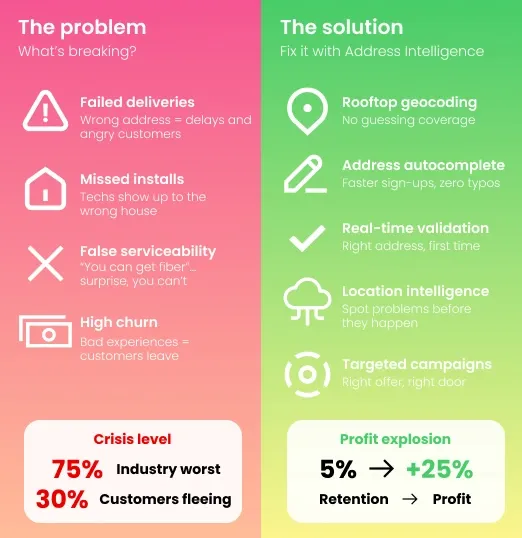
The telecom industry has a trust problem, with some of the lowest customer satisfaction scores across any industry. High churn rates are the norm. Inaccurate address data often causes:
- Failed installations
- Delayed hardware shipments
- Missed technician appointments
- Incorrect service availability results
But here’s the good news: telecom companies that increase retention by just 5% can see profits jump by 25%. That’s no small potatoes. 🥔
Here’s how accurate address products help to improve telecom customer experience:
- Rooftop-accurate geocoding – helps determine serviceability down to the exact building, avoiding wasted installs.
- Autocomplete at sign-up – reduces drop-offs and data errors.
- Validated addresses – make sure modems, routers, and fiber equipment arrive at the correct place.
- Location intelligence – helps identify patterns in service quality issues, making proactive maintenance possible.
- Personalized communications and promos – can be sent by region, down to the block or building, improving relevance.
Telecom customer experience success depends on precision—whether you’re installing fiber, activating service, or diagnosing issues remotely. If you don’t know exactly where your customer is, everything else breaks down.
Autocomplete cuts down on sign-up friction while address verification ensures your techs show up at the right door, not the wrong block. Rooftop geocoding gives you hyper-local serviceability checks, reducing false availability claims and costly rework.
With accurate address data, you can also segment and personalize offers by geography, improving campaign effectiveness and user experience. Ultimately, you improve customer satisfaction, reduce churn, and create a network of happy subscribers who get what they need, where and when they need it.
Healthcare patient experience
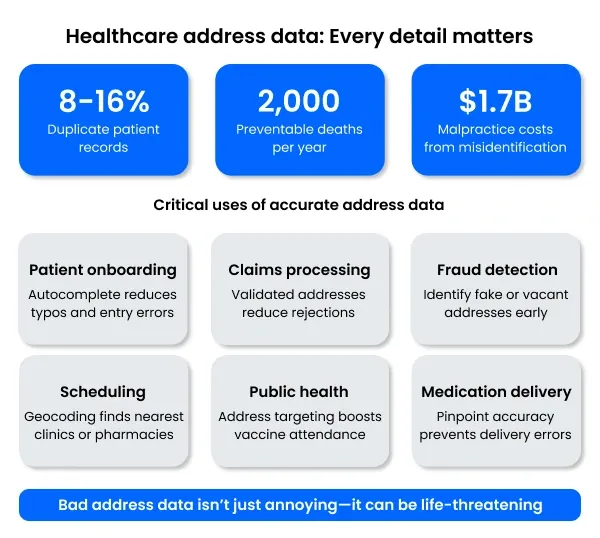
In healthcare, every detail matters, especially when it comes to patient data. But with duplicate patient records affecting 8% to 12% of records (and as high as 16% in larger systems), the consequences go far beyond messy databases. We're talking nearly 2,000 preventable deaths a year and $1.7 billion in malpractice costs tied to misidentification.
Accurate address data is vital for healthcare patient experience in:
- Patient onboarding – autocomplete reduces typos and entry errors.
- Claims processing – validated addresses reduce rejections due to mismatched records.
- Fraud detection - by identifying fake or vacant addresses early.
- Appointment scheduling – geocoding helps identify the nearest clinics or pharmacies.
- Public health engagement – precise address targeting boosts attendance for vaccination drives or screenings.
- Medication delivery – especially for at-home care, requires pinpoint address accuracy to avoid errors.
- Patient matching - the address is one of the most important pieces of information to tie a patient to.
Bad address data isn’t just annoying—it can be life-threatening. Accurate addresses are critical for everything from prescription delivery to billing and public health outreach.
When patients enter their address, autocomplete makes the process faster and less error-prone, while validation ensures that data is accurate and actionable.
Rooftop-level geocoding helps health systems plan coverage zones, optimize patient communications, and meet compliance standards like HIPAA.
Organizations that clean and verify address data see fewer denied claims, reduced duplicate records, and higher patient trust, making it easier to deliver care when and where it’s needed most.
Insurance customer experience
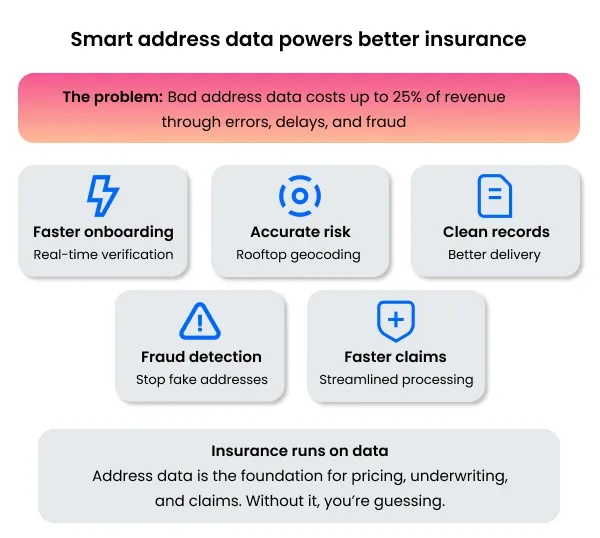
Bad address data in insurance creates pricing errors, claim delays, and frustrated customers, potentially eating up to 25% of your revenue through inefficiency and fraud. And with 46% of consumers saying insurance customer experience is a top factor when choosing a provider, accuracy and ease are everything. That’s where smart address products come in clutch.
High-quality address data enables:
- Faster onboarding – through real-time autocomplete and address verification.
- Rooftop geocoding – for accurate risk assessments—think flood zones, wildfire proximity, or roof types.
- Clean address records – reduce policy delivery issues and improve customer communication.
- Fraud detection – by identifying fake, invalid, or vacant addresses early in the application process.
- Streamlined claims processing – especially at the first notice of loss—thanks to standardized and enriched location data.
Insurance runs on data, and address data is often the root of pricing, underwriting, and claims workflows. Without it, you're guessing.
Rooftop geocoding lets you assess risk down to the structure level: is it in a flood zone? On a hillside? Near a fire-prone area? That insight powers fairer, more accurate premiums and minimizes disputes.
At the same time, clean address records prevent policy documents from being mailed to the wrong place and help underwriters detect fraudulent applications faster.
Address verification at the quote or application stage also smooths onboarding and cuts down manual review. It’s not just a back-office win—it’s the foundation for trust, speed, and loyalty in every customer interaction.
Fintech customer experience
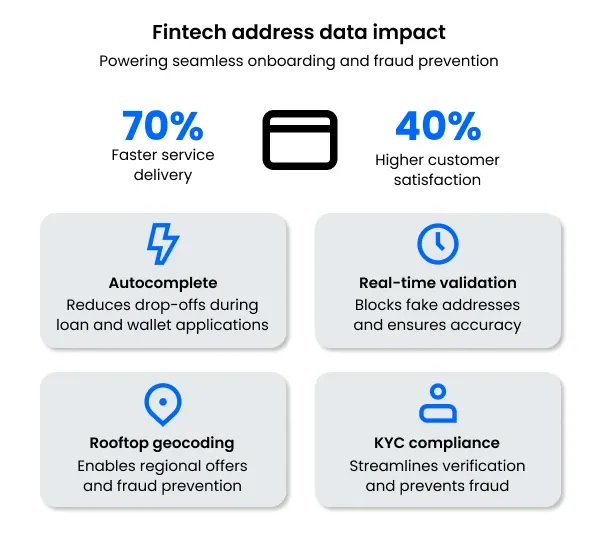
Fintech thrives on seamless onboarding, real-time verification, and fraud prevention—all of which are powered by accurate address data. Fintech customer experience focused on accurate address data sees up to 70% faster service delivery and 40% higher customer satisfaction scores—making trust and growth scalable.
How address products make onboarding and servicing seamless:
- Autocomplete – improves completion rates for loan, credit, and digital wallet applications.
- Real-time validation – ensures only accurate, existing addresses are entered.
- Rooftop geocoding – supports geofenced offers, regional lending criteria, and fraud prevention.
- Global address APIs – let fintechs scale across borders with confidence and local accuracy.
- Verified addresses – streamline KYC (Know Your Customer) checks and help prevent fraud.
Autocomplete reduces drop-offs during sign-up, validation blocks fake or mistyped addresses, and rooftop geocoding helps tailor offerings based on real-world context. This means users in coastal regions can be offered different loan options than urban users, for example.
Clean address data also helps with KYC/AML compliance, prevents synthetic identity fraud, and accelerates customer service resolution by ensuring agents have correct, standardized location info from the jump.
Whether you’re launching in a new country or scaling your user base, accurate address data ensures your customer experience is consistent, compliant, and conversion-friendly.
Address data is the unsung hero of great experiences
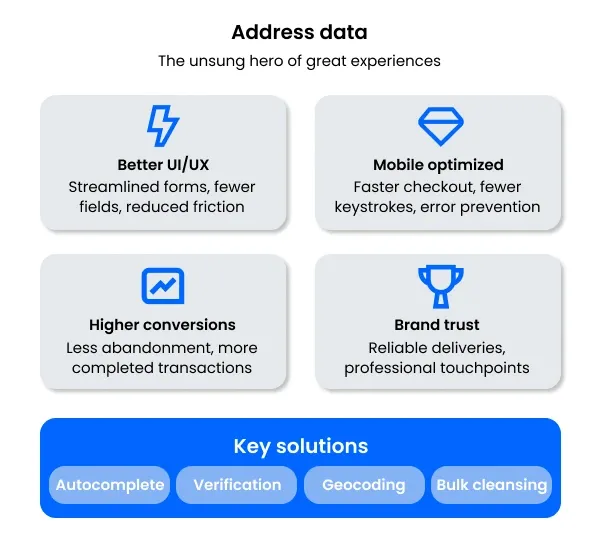
No matter your industry, your customers expect fast, reliable, and personalized service, and accurate address data quietly powers all of it. It turns clunky user interfaces (UI) into intuitive, streamlined forms that are easy to navigate and pleasant to look at. With address autocomplete and validation, you can reduce the number of fields a user sees, minimize friction, and prevent that dreaded “please enter a valid address” red text moment, keeping your interface sleek, functional, and frustration-free.
From a user experience (UX) perspective, address tools reduce keystrokes, speed up checkout and signup flows, and prevent errors before they happen, especially on mobile, where every tap counts. When users can complete tasks quickly and confidently, they’re more likely to convert, less likely to abandon, and far more likely to come back.
And on the customer experience (CX) front, verified address data ensures follow-through: deliveries arrive on time, service installations go off without a hitch, and communications land where they’re supposed to. It reinforces your brand’s credibility and professionalism at every touchpoint—from the first impression to the ongoing relationship. It also supports personalization and localization efforts, helping businesses provide offers and support that are relevant to each user’s actual location.
So when you implement address solutions like autocomplete, verification, rooftop geocoding, and bulk cleansing, you’re not just cleaning up back-end data—you’re designing smarter interfaces, creating smoother user journeys, and building brand loyalty through positive, polished experiences.


